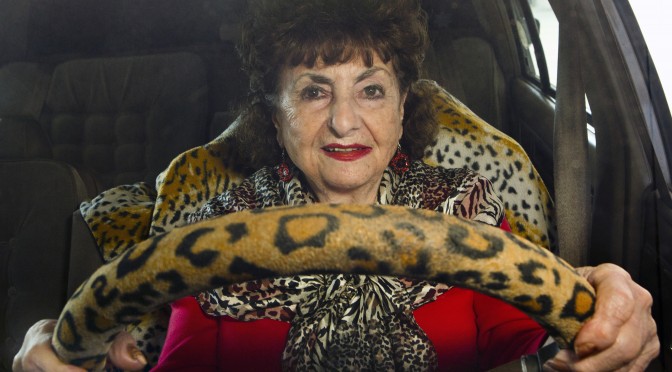
Work Hard. Play Hard. Give Back.
That’s the motto of Seattle-based production company Inflatable Film, as well as the husband and wife duo who run it. Leah Warshawski and Todd Soliday are currently in post-production on their film, Big Sonia, detailing the life of a woman who easily embodies the motto.
The title is by no means a comment on her stature. Standing at just over five feet tall and barely able to peek over the steering wheel, the story follows 89-year-old Sonia Warshawski, who we see still driving herself to work every day.
Big doesn’t even begin to cover it with Sonia; she is hilarious, charming, and above all, a survivor. 
She survived the Holocaust through three death camps, two death marches and a bullet to the chest on Liberation Day, which missed her heart by an inch. She survived running her late husband’s tailor shop in a closed down mall, until last September, when the mall shut down for good.
Sonia also happens to be Leah’s grandmother, but don’t let that fool you. Big Sonia isn’t about the relationship between grandmother and granddaughter, nor is it a film focused on the Holocaust. It’s all about Sonia. Despite the heavy undertones—a necessary part of her narrative—Sonia’s witty and infectious personality steals the show.
“She’s a total diva, she’s always wanted to be a movie star. She talks non-stop,” Leah said. “So she actually tells her own story pretty well. I mean, there’s no need for a narrator.”
Todd agrees, and has been captivated by Sonia. And he is not the only one.
“My first impression is that she’s an irresistible person. But then you hang out in her shop and see the line of people that pile up with tailoring on their arm, but that’s not really why they’re there because she doesn’t sew. They’re there for healing. They’re there for banter. They’re there for stories. They’re there for their own redemption,” Todd said.
Sonia loves interacting with people, and those who engage go into what Todd refers to as “Sonia time.”
“She’s a saleswoman. I mean, she is all about the sale. But she just loves that interaction,” he said. “So she takes a fitting that should take five minutes and turns it into an hour.”
Leah says Todd’s role on the production team keeps them honest in their storytelling to avoid it becoming too family-focused.
“Yes, her story is incredible, this incredible story of survival, not only during the war, but the fact that she survived in this mall for 35 years while it was closing,” Todd said. “We’re not telling because she is incredible or that story is incredible, but we think it’s relatable.”
Sonia is now a public speaker, primarily talking to middle schoolers throughout Kansas City, about her story and empathy.
“She didn’t always do that, but she looked around at the world about 10 years ago and realized things haven’t changed much. There is still discrimination, there is still bullying, there is still hate,” Leah said. “The world’s not much better. So she’s talking about what’s happened and inspiring all kinds of different people.”
Todd said she is relatable because we’ve all survived some level of trauma in our lives.
“And it’s a big deal, no matter how big it was relative to the Holocaust or the bully who picked on you in seventh grade,” he said.
They want the film to do the same: reach an audience of any age, and tell the story of the Holocaust.
“Within our lifetime they’re all going to be gone. She’s one of the last [Holocaust survivors],” Leah said. “So how do we tell her story in a way that is going to live on and not make it so archaic? You know, make it modern enough to have an impact on kids?”
The answers, for them, lie not in dark photos of the past, but in a mix of interviews and animation. The style is similar to that of their 2013 documentary, Finding Hillywood, about a traveling film festival in Rwanda.
The graphic artist for the film is Kansas City-based, where Sonia lives. However, aside from one producer in L.A., the rest of their production team is made up of the Seattle film community, which they are happy to consider themselves a part of.
“Every time we think about leaving [Seattle], we just… we can’t go because the community always pulls us back,” Leah said. “The community of filmmakers here… I know everybody says it, but the community is just really important.”
Todd is equally enamored with Seattle. “I’ve never been any place that’s been so diverse; that you can do good work—work that you believe in—and then cut out at 4 and go paddling,” he said.
They have about 90 percent of their filming finished, and are currently working on editing and post-production in Seattle. They are working with video production studio Lightpress, the recording studio Bad Animals, and composer Bradley Laina. Their story producer is Eric Frith, and Doug Loviska and Todd Soliday are editing the film.
The film is shot in Kansas City; Napa, California; and Seattle—all places where members of Sonia’s family are based. They would like to go to Poland to capture more about her past, but they don’t have the funding.
They are currently fundraising for the film and applying for grants, which has been their biggest hurdle. Without further funding, they cannot keep working on the film.
Their biggest monetary success thus far has been with personal donations. They have hosted several “fundraising house parties” in which they show clips and talk about their film to a group of friends that the host invites. They also have a donate button on their website at www.BigSonia.com.
Once they get to the final stretch of the project—outreach and distribution—they will likely launch a crowdfunding campaign. They learned the hard way while working on Finding Hillywood that this part of the process costs a lot more than one might expect, and they launched the film’s crowdfunding platform too early.
The couple also does some contract work, primarily promotional materials for the big tech companies in Seattle, which they enjoy. But their passion is documentary filmmaking.
“You get access to a completely different lifestyle, a completely different way of living. Sometimes you become that,” Todd said. “It’s hard to extract and that becomes part of you, and you’re constantly kind of morphing into whatever your last film was, I guess.”
This has certainly been the case for Todd while filming for Big Sonia, which he said constantly inspired him to be a better person. It also made him feel like he should pick up the phone and call his mom to tell her he loved her, which seems to be the unofficial PSA of the film. Many of the kids Sonia had spoken to said she had inspired them to do the same, despite being at an age where actively loving your mom is arguably uncool.
As Leah said, “Call your mom. Do something with yourself. Get off your butt.”
While Sonia’s story is irrefutably incredible, the complexity of the film resides in the showing of her vulnerability, and what makes her human.
“There’s this woman who’s been through so much and, ‘Wow, it’s amazing that she’s getting up every day and going to work.’ But she’s going to work to keep the demons away,” Leah said. “Because being busy means she doesn’t have to think about the stuff that comes up when it’s quiet. So it’s never quiet. And her family has a difficult time living around her. She’s very judgmental.”
Leah, who did not grow up around her grandmother, has enjoyed learning more about her, and hopes the film will encourage other people to learn their family stories.
“You kind of put those people up on a pedestal and they’re heroes. And you spend more time with people and you start to see their humanity and their vulnerability,” she said. “That’s what’s been so interesting because I haven’t known that side of her before, so it’s been really great.”
Caroline, a teenager Sonia spoke to four years ago, when the girl was just 13, is one of many who has been deeply affected by Sonia’s story. During interviews she detailed how she no longer leaves the house without acknowledging her mother’s importance in her life and is currently in the process of trying to start an anti-bullying foundation in honor of the wisdom Sonia passed along to her.
“We don’t need Leah or her family saying Sonia is this impactful person—we have characters that we have tracked that are going out into the world. Sonia’s legacy will go on,” Todd said. “Not only through her family, but through the hundreds of people that she’s touched, including the unreachable teenage kids who are on their phones all the time. She breaks through that. She crosses the barrier.”
To learn more about Big Sonia, or to donate to the film, visit www.BigSonia.com.
By Stephanie Hoover & Crystal Foley Staff Writers
Photos by Gloria Feinstein
Originally posted on Media Inc.
